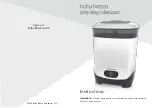
8
english
PROFIBUS is a manufacturer-neutral, open fieldbus
standard defined by international standards EN 50170 and
EN 50254.
3.1
Bus principle
A PROFIBUS system consists of masters and slaves.
There are two classes of master. A PLC is generally
considered a master in Class 1 (DPM1). A DPM1 initializes
the peripheral devices with the necessary parameters. The
slaves then switch to cyclical mode and are monitored by
the master to see whether they remain accessible. There
must always be at least one DPM1 in a PROFIBUS
system. If there are multiple Class 1 masters, then a slave
can be assigned to only one DPM1.
A Class 2 master (DPM2) is also referred to as a
configuration master. DPM2 are engineering, configuration
and operating devices. They are used for start up,
maintenance and diagnostics in order to configure or
monitor the connected devices. DPM2 do not have to be
permanently present during operation.
The basic functionality between Class 1 masters and
slaves is referred to as DP-V0. It includes configuration,
operation and monitoring, where the slaves as well check
the presence of the master using response monitoring.
DP-V1 refers to the functionality for acyclic data exchange
and alarm handling. This takes place between slaves
which support DP-V2 and Class 2 masters. A slave can
communicate with various DPM2 via DP-V1.
DP-V2 handles isochrone data exchange, slave
communication and time synchronization. This makes it
possible to fix the cycle time of the controller to a fixed
value and synchronize the slaves to it.
BTL7-T500… supports DP-V0, DP-V1 and DP-V2.
In addition to manufacturer-neutral functions the sensor
also supports Classes 3 and 4 according to the encoder
profile.
3
PROFIBUS Basics
3.2
System start
After start up the BTL7-T500… expects a parameterization
telegram from the master. Included are at minimum the
information specified by the standard (e.g. ID number,
master address or watchdog time). Additional user-specific
parameters may also be sent.
Then the BTL7-T500… waits for a configuration telegram.
This specifies the way in which the data are exchanged in
cyclical mode. Various data telegrams are available here to
choose from (see section 4.4 on page 15).
If both programming and configuration were accepted,
then the BTL7-T500… can exchange user data with the
master.
3.3
PROFIdrive object model
PROFIdrive is a modular, manufacturer-neutral device
profile for drive devices which offers the same functionality
for PROFIBUS and PROFINET.
The model which PROFIdrive uses as the basis is based
on the previously described bus principle. The various
components are divided into three device classes:
– The Class 1 master is the controller. It is connected to
one or more drives or axes and controls the entire
system.
– Slaves such as the BTL7-T500… magnetostrictive
linear position sensor are referred to as a peripheral
device (P-Device). They are connected to at least one
controller which monitors or controls them.
– Class 2 masters are called supervisors. The supervisor
is generally a computer with configuration software
which can be used to set parameters and monitor the
peripheral devices.
Each station on the bus consists of one network interface
and one or more devices. The network interface connects
the station to the network. To uniquely identify a
PROFIdrive device the network, station and device must
be specified.
A PROFIdrive device in turn consists of one or more
functional objects which represent its function. The
BTL7-T500… is a homogeneous peripheral device with an
encoder unit. In addition there is a communication object
which connects the drive objects to the network interface.
In addition, the communication object that establishes a
relationship between the network interface and the drive
object is defined.
BTL7-T500-…
Configuration Guide
Summary of Contents for BTL7-T500 Series
Page 1: ...BTL7 T500 Konfigurationsanleitung deutsch ...
Page 2: ...www balluff com ...
Page 42: ...BTL7 T500 Configuration Guide english ...
Page 43: ...www balluff com ...
















































